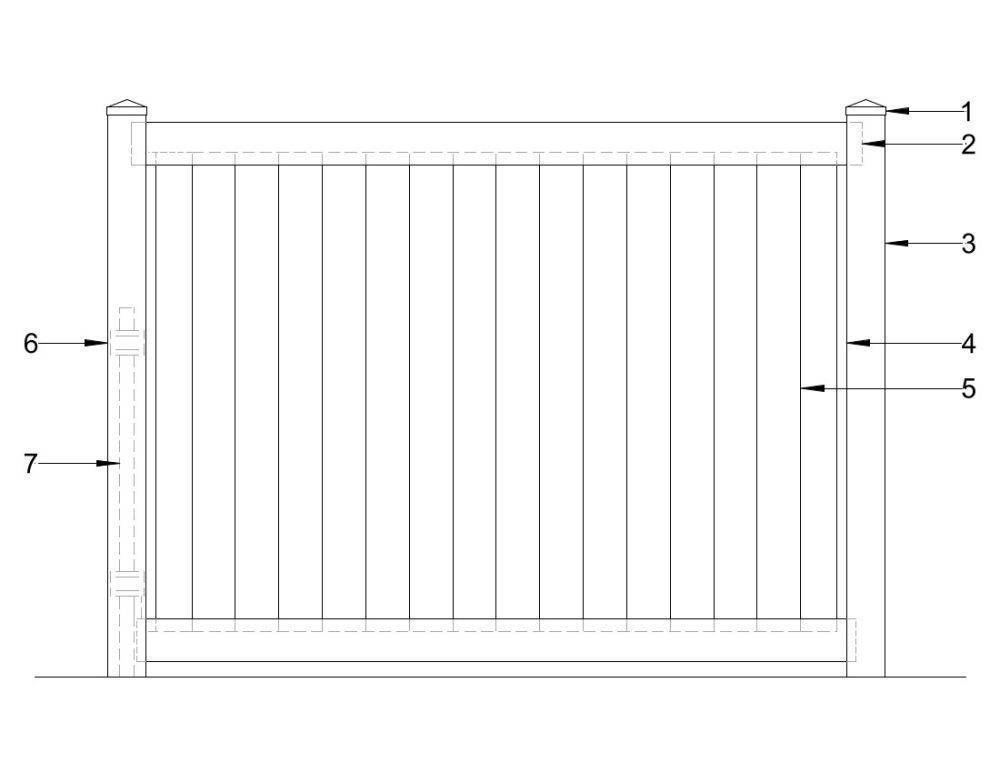
The Complete Guide to Vinyl Privacy Fence Parts
Vinyl fence is a very popular, low-maintenance alternative to wood fence. It is most commonly seen as a privacy fence, although it can also be used to create vinyl picket fences, vinyl ranch rail and more.
While different manufacturers might make their components slightly differently, the basic building blocks of vinyl privacy fences are usually the same. Let’s take a closer look at the vinyl privacy fence parts that you will need to build your new fence.
Pictured Vinyl Privacy Fence Parts
Different vinyl fence systems are made slightly differently, and different manufacturers might create slightly different profiles, use different colors of PVC and make other minor changes to the overall design of the fence.
However, most vinyl privacy fences are made up of the same basic parts that are used, kind of like building blocks to create the fence on site. These are the labeled parts on the sketch above.
1. Post Cap
Like other types of fence, each vinyl fence post is capped to improve the appearance of the fence and to prevent water, debris and other substances from getting into the post.
Vinyl privacy fence post caps usually slip over the outside of the fence post, and sometimes, an adhesive is used to ensure they stay in place. There are many different vinyl fence post cap designs, including some that integrate solar-powered lights and more.
2. Vinyl Fence Rails
Vinyl Privacy fence rails are generally shaped like a U, with a solid edge on one side and an open groove on the other. This allows the fence installer to slip the pickets or fence boards into the fence rails, which then hold them in place.
Vinyl fence rails are installed into routered holes in fence posts, and they are available in different designs and sizes. Sometimes, vinyl fence rails and posts are a different color from the fence pickets, giving the fence a two-tone design.
3. Vinyl Fence Posts
Vinyl privacy fence posts are square, hollow tubes of vinyl, usually either 5 x 5 inches or 4 x 4 inches. They can be installed in various ways, and they are usually installed every 7 or 8 feet along the fence line and at each corner, end and gate.
Vinyl fence posts can be installed in different ways, including using collars and steel posts, either with baseplates or pounded into the ground, or embedded in concrete. The length of the post will vary based on the type of installation used.
4. U-Channels
U-channels are vinyl fence components that are installed on the edges of the T&G fence boards, including where they have been cut to fit, which gives the fence a finished, net look. They help to hold the fence panels together once installed, and there are usually two per panel of vinyl privacy fence.
5. T&G Pickets or Fence Boards
The fence boards that are used to build vinyl privacy fences are also called T&G or tongue and groove pickets. As the name suggests, the long, vertical edges of these boards fit into each other, and the top and bottom edges of the boards are slotted into the vinyl fence rails.
T&G pickets for vinyl fences come in different widths, ranging from about 6” to nearly 12” wide, depending on the manufacturer or design.
6. Post Collar
If your vinyl privacy fence is being installed using a steel post, either by pounding or base plated to a surface, you will need post collars to complete the installation.
These round collars fit inside the square posts and have an elliptical-shaped slot in the center that can be used to level the fence post on the steel post. Once they’re properly aligned, they are fastened in place using a tech screw or self-drilling screw.
7. Steel Post
If your fence install is done using pounded or base plated posts instead of concrete, you will need a steel post that will be installed inside the vinyl fence post using collars, as mentioned above. ‘
Different sizes of posts can be used as your inner vinyl fence post, depending on the site and other factors.
Other Vinyl Privacy Fence Components
Aside from the numbered vinyl privacy fence components mentioned above, there are several other items that might be used to build your fence, depending on the vinyl fence system and the installation method.
These might include metal stiffeners, which are often used in the bottom rail of vinyl fencing to strengthen the panel, and vertical stiffeners which are used in vinyl gate posts to add more rigidity and strength.
There are also different sizes of vinyl used to create gate frames, and most manufacturers sell vinyl gate kits that include corners, hinges, latches and other equipment.
Different types of vinyl fences have many other components as well, and there are also optional extras like lattice panels and more.
While vinyl fence might seem simple enough, based on this parts list, it does take a considerable amount of skill to install correctly. So if you’re not a fence pro, it’s a good idea to find a vinyl fence company in your area to install your fence for you.


